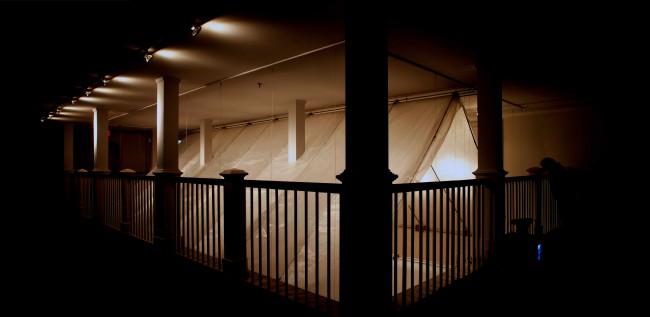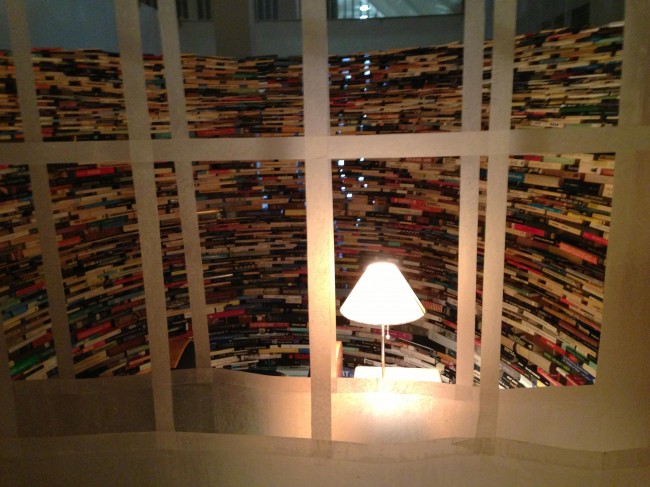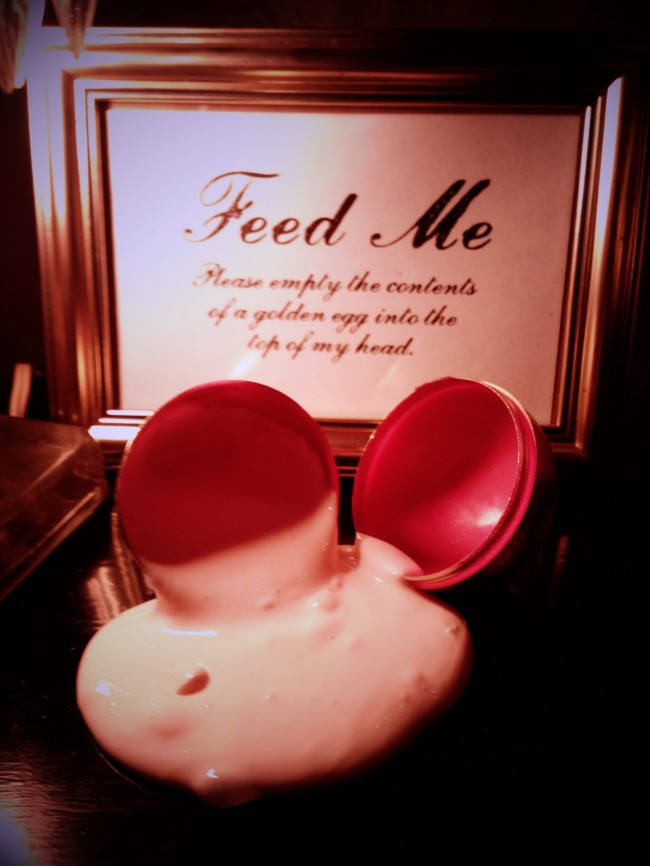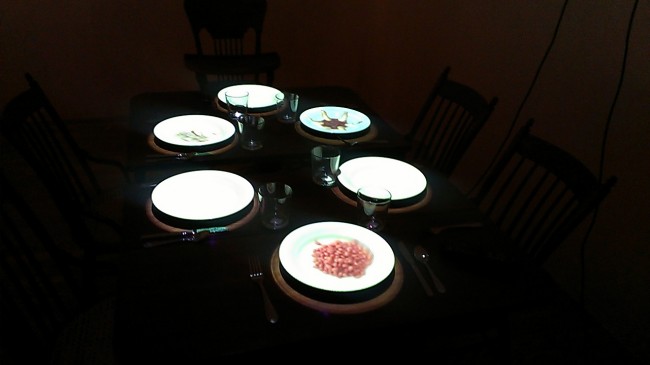An American Appetite for Living and Consuming
By Christopher Hoeting
Two new exhibits examine perspectives on domestic living spaces in site-specific collaborations about American Life.
On this old fashion road trip, I discovered the dichotomy of Living and Consuming; A concept that is as American as apple pie, not just in American Life, but also in American Art. My trip started in Yellow Springs with the exhibition entitled Appetite: An American Pastime at the Herndon Gallery in the early afternoon and then on to a view of The Living Room mid-installation at The Contemporary Arts Center in Cincinnati.
These exhibitions feature two curated groupings of artists that examine the psychological effects of architectural spaces. Both exhibits use a democratic approach led by the broad architectural frameworks designed by curators to create a canopy for artists to explore concepts and themes that yield very different results.
Herndon Gallery has had a renaissance under the oversight of Creative Director Dennie Eagleson, who has had a strong two-year run of exhibitions and intelligent programming in the newly remodeled two-story gallery. While visiting several months ago I noticed the commitment of the organizers, both Eagleson and Casselli to go the extra step in putting forward unique programming at Antioch College. I realized in preparation for Appetite that they would remove a large spiral staircase and overhead light fixtures to accommodate the two story site specific installation.
Upon arriving to the horseshoe arrangement of academic halls at Antioch College campus, I step into the second to last building on the right. Through the doors and into Herndon Gallery’s threshold of the current exhibition entitled Appetite: The American Pastime, where I was met with a towering translucent structure fitted with a pitched roof, windows, and a green surround. I enter into the dark and quiet two story wax paper house suspended from the ceiling, reminiscent of Do Ho Suh’s fabric house series, but with more architectural delineation within the interior spaces. Where Do Ho Suh’s house series speak about architecture and specificity, the house that Michael Casselli built as a framework for this exhibition focus on the home as a symbol of universal suburban American life. A surrounded of exterior windows turned light boxes around the perimeter of the house create a cathedral type lighting effect that reinforces the psychological aspects of containment within the motif of the house. The segmented floor plans create emphasis on division both in interior and exterior. From a well-crafted armature of a wood and steel framework hang wax paper rooms that act as a partition or an envelope for concepts to unfold from within its six-inch walls and two miles of wax paper.

Dennie noticed me in the gallery from the second story investigating the house and went out of her way to “turn on the whole show”. The wax paper house and exterior light box window treatments created such a beautiful resulting atmospheric light that I had not noticed that the exhibition was not “on”. I was enamored with the structural space set forth by curator, organizer, and artists of Appetite, Michael Casselli and the seamless integration of artists spaces as a unified whole, that seeing the house come to life with activity after being so still created a child like experience of surprise inside the four-room interior. As Dennie appeared and disappeared light boxes came on, video projections began and sound protruded from the house as the multimedia installation was animated. I explored the exhibition and enjoyed the strength of the overall tactile quality of the found objects, light, sound, video and interactive elements.
Within the wax paper walls of Michael Casselli’s house is a curatorial collaboration of four installations by artists Eric Dyer and Maggie Hoffman, Raul Vincent Enriquez, Stefanie Koseff, and political/cultural theorist, Kurt Miyazaki. Each work is intentionally integrated into the piece as a whole and stands as one single artwork in the exhibition.

Entering into the first room of the house is Raul Vincent Enriquez’s video projection of food that is added to daily via live stream. Along with the small screen are a sound track playing and a larger video piece projecting stills at knee height directly onto a wax paper wall. One of Enriquez’s artworks in this series that first caught my eye is a grouping of twenty or so plastic magnifying apparati with plates set atop of a light box. The viewer peers through the magnifying glass to see different obscure samples that seem to be food based, but are reminiscent of a closer examination of organic material through a microscope. The overall feel of the imagery takes on an investigative approach that is documentary like and appears to be shot directly from the artist’s life.

Moving straight into the second room is the political/cultural theorist, Kurt Miyazaki’s installation. A large half circle that projects out like the edge of a woven basket, toward the audience in an organic wall made entirely out of stacked books that transform the room. two small book presentations set atop wooden boxes with reading lights stand behind this large wall sculpture. Two framed pictures hang overhead with text based organic images in a balanced well-organized space. Dennie explains to me that Kurt Miyazaki periodically enters behind the wall of books and engages in an on-going performance where he sits in a chair and reads, which can be seen voyeuristically from the exterior of the house through an opening in the window threshold. As you turn backward into the third room, What is commonly referred to as the “Feed Me” room with the golden eggs and the refrigerator full of beer, lies an installation created by Eric Dyer and Maggie Hoffman, whom are a performance collaborative called Radiohole based out of Brooklyn. This installation is by far the most disturbing and disorganized work in the show. The piece is literally a cluttered room with trash, cans and newspaper, thrown about with a small refrigerator in the corner with a sign that says “Free Beer.” Beside the mess in a free standing figure with a casting glowing red light pouring out from within the body. The mouth is wide open and the interior is hallowed out. The audience is invited to “Feed” the figure with an egg that contains a silica type substance. I of course pour this down the throat of the figures mouth and walk around the space as the substance slowly pours down like slurry through the figure’s abdomen and empties onto the floor. Although the work is the least aesthetically pleasing piece, it most effectively brings me back to the concept of Appetite and I cannot help but to revisit the prior rooms to think about the excesses of food, appetite for knowledge and reading, and just overall consumption, perhaps surpassing baseball as the true American sport.

In the forth room and most sophisticated installation of the group, New York based video artist Stefanie Koseff sets a table with a six channel projection and sound piece that fills the white plates of a dinner setting from above. The traditional setting of found objects is perfectly timed with movement and sound as food is served, redistributed and eaten. The projection periodically creates a circular movement with flashing food appearing and disappearing in a rhythmic fashion. The sound of plates and silverware accompany the movements as an empty table is filled and emptied in a timely fashion in an exquisite time based work that gives action to the meaning of Appetite.

Appetite: An American Pastime is a mature and content heavy exhibition, which is high on emotive reach, psychological drama, and reconditioning of existing objects where Michael Casselli beautifully weaves together many threads under one wax roof. The clarity of concept dictated within the spaces show visions of seasoned artists that integrate object focused multimedia installations that coherently create a whole. Casselli’s theatrical background resonates in the exhibition both with his collaborations of colleagues from New York, Chicago, and Dayton and his ability to set a stage as a curator and has masterfully framed his concept of American Appetite and raising the bar in the Herndon Gallery for future exhibitions.
As follow up to Appetite and a short break of my own consumption I now find myself at the threshold of The Contemporary Arts Center in Cincinnati along Walnut Street. For my second stop I was privileged to see a preview of the new exhibition curated by Justine Ludwig entitled The Living Room. Ludwig takes a break from her travels over seas to curate a new hyper local exhibition on the second floor as a complement to the new Patti Smith works. Ludwig comments, “I think it is important to present artwork created by local and international artists within the institution. It is about presenting the work on the same level and showcasing the amazing art that is happening on the other side of the globe as well as in our own back yard. I see it as offering a transnational vision of contemporary artistic practice.”

Ludwig’s plan for the exhibit is to celebrate the rich history of making in the City of Cincinnati by revisiting the historical roots of contemporary craft movement in a series of traditional domestic spaces inside the Center’s long rectangular gallery space, which I might add creates a perfect landscape oriented tableau for The Living Room. Paul Coors creates a memorable text piece “The Living Room” for the exhibit that reinforces the show room type quality and Sears reference that is inherent in the overall feel of the exhibit. I would also credit Coors for effectively framing the show through the lens of text and design in its simplest form.
The exhibition presents several types of “living spaces”. The sitting area features an elaborately tiled fireplace as the main focal point which is created out of a collaboration with Rookwood Pottery Company by artists Katie Parker (Assistant Professor of Fine Arts, UC: DAAP), Guy Michael Davis, (Adjunct Assistant Professor of Fine Arts, UC: DAAP), and artist Terence Hammonds. Hammonds is also on staff at Rookwood where he works as both a glazing artisan, but is well known in Cincinnati for his printmaking work, which appears in the hand made Hip Hop wallpaper that flanks the fireplace. Similar to the ceramic heroes whose portraits ornament the fireplace, the wallpaper reflects the history of radical ideas and fashions that ultimately led to social change.

This elaborately decorated fireplace is actually one of two created by the three-artist team mentioned above. The other is to be exhibited at the ICFF in New York as a representation of the next movement in an excellent American craft company (Rookwood Pottery), which is known not only for creating spaces in the region, but also over the millennia in historic buildings and homes Nationally and Internationally. Guy Michael Davis mentions to me during our conversation that not since the 1893 Columbian Exposition has Rookwood’s participated in an international exhibition. With the support of the current owners of Rookwood Pottery, Martin and Marilyn Wade have made the inclusion of the fireplace as the centerpiece of The Living Room exhibit possible.
Katie Parker shared with me that “After accessing Rookwood’s archives, the artists were allowed to mine both past and present product and alter it, to make a piece that is a combined vision of their interests and studio practices. Modern-day Rookwood tiles above the mantel echo a 15th century tapestry from the Indian subcontinent; however, set amid the deer and cheetah that would be found in the original tapestry are now figures of dogs, pigeons and rodents seen every day in Over-the-Rhine, the historic neighborhood in Cincinnati where the new factory is currently located. Inspired also by the idea of a utopian vision gone awry, the artists played to their strengths of printmaking and drawing, and created a mural using the traditional cuenca process. The artists took a local lore approach to the ornamentation, using regional flora for the hand-applied relief.”
Parker continues, “Tiles incorporated into the center of the fireplace portray individuals important to the artists – their ceramics heroes of past and present”, which include the likes of Kataro Shirayamadani, Mary Louise McLaughlin, Josiah Wedgwood, Eva Zeisel, Adelaide Alsop Robineau, Russel Wright, Johann Friedrich Bottger, Maria Longworth Nichols Storer, and Isaac Scott Hathaway. The process of Lino cuts – called Cuenca were also incorporated into the piece. Parker remarks that, “We all worked on drawings together, and then laid them out onto 12×12” sheets of linoleum that we carved into. These tiles went into a RAM tile press, making our cuts a relief that we filled with Rookwood glazes (similar to cloisonné). This is an old process, and allows for infinite image options using a single tile mold.”
To the right and left of this contemporary Rookwood Collaboration is a custom-made sofa; a “bearskin” rug sculpted from wood, ceramic chandeliers and wall treatments incorporating both print and projection. In the Front section of the gallery Paul Coors has constructed a multichannel video projection that he himself jokingly called his Living Room, or rather the TV room. Coors explains that the artwork is a look into his personal space that houses his studio and performance space in the Ice Cream Factory in the neighborhood of Brighton. Additional Collaborations feature a dining area that holds a sunken table and low hanging light fixtures. The rear of the gallery is conceived of as a private exterior space, a “backyard” where during my visit the large tree house was being construction by the design collective Such + Such.
Curator: Justine Ludwig adds, “When I initiated the project I intentionally left it quite open so I was not surprised by anything. I was also in contact with the artists throughout the entire process. It was amazing watching the gallery space transform into a series of rooms and how the individual elements came together. The moment when the exhibition really came together was at the opening—when the exhibition finally became an occupied space. I spent most of the following weekend at the CAC and I loved coming down to the gallery and seeing people sitting on the couch or in the tree house just talking or thinking.
To my surprise this group approach to creating space as a larger concept of human interaction rather than purely a framework to fill with artworks is effectively engaging. Contrasting the Appetite exhibition at Herndon Gallery, The Contemporary Arts Center incorporated the infusion of highly designed objects, constructed experiences with a strong aesthetic focus. The more architecturally driven intellectual approach to space is one of high-level design in form and suggests function. There are aspect of this installation that remind me of the Cincinnati Wing of the Art Museum, with tableaux of furniture and functional art filled with a saturation of highly pleasing aesthetic experiences that are removed from the museum platforms and begging for audience engagement.
The Contemporary Art Center exhibition shares this design heavy concept and threads together architecturally influenced decisions driven first and foremost by aesthetics. The arts and craft celebratory exhibit is a breadth of fresh air to the last several years of curated exhibits that were out of the box, interactive or just plain stripped down. It is ironic that to find a space that works in Cincinnati, all that Justine Ludwig needed to do is look right inside the neighborhoods that present a space for the human spirit to occupy.
Herndon Gallery, Antioch College
“Appetite: An American Pastime” closes:
Friday, May 24, 2013 – 1:00pm to 4:00pm
Gallery hours are Tuesday through Saturday, from 1:00 to 4:00 p.m.
The Contemporary Arts Center
“The Living Room”
May 18—September 2, 2013